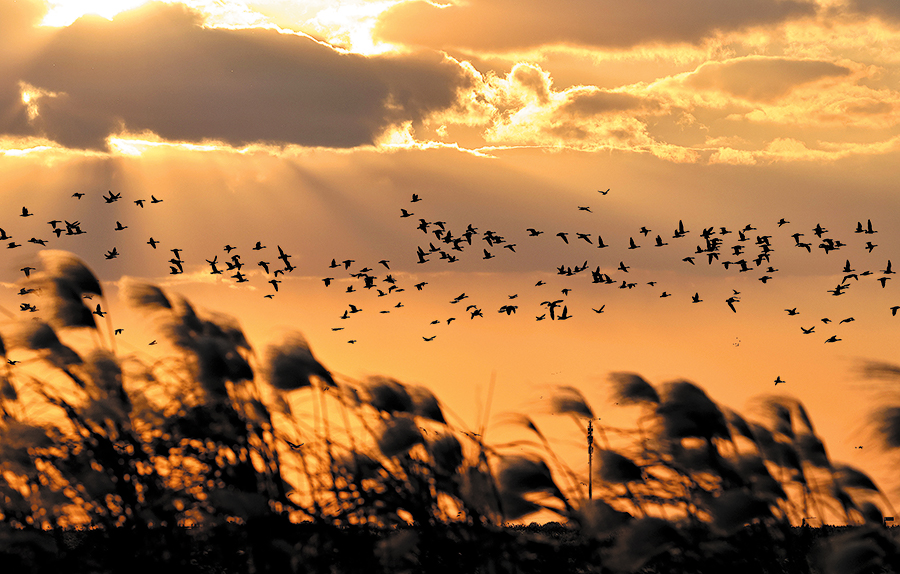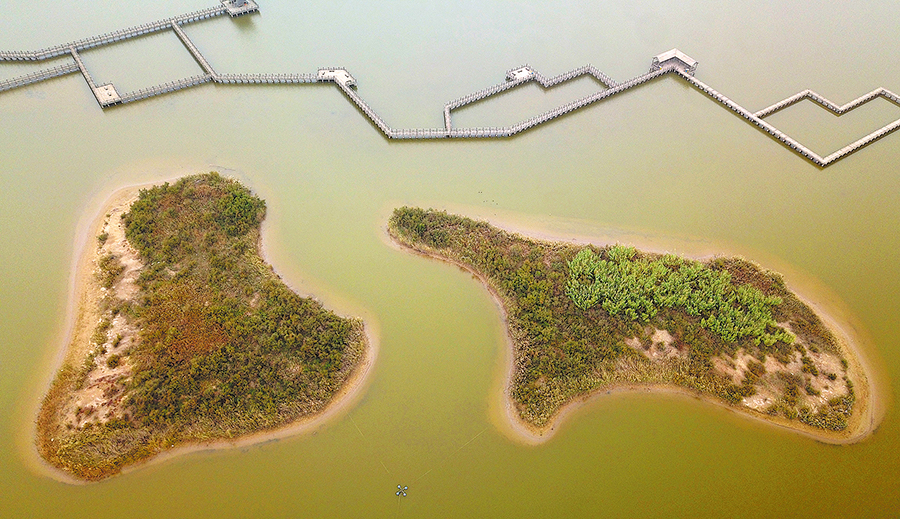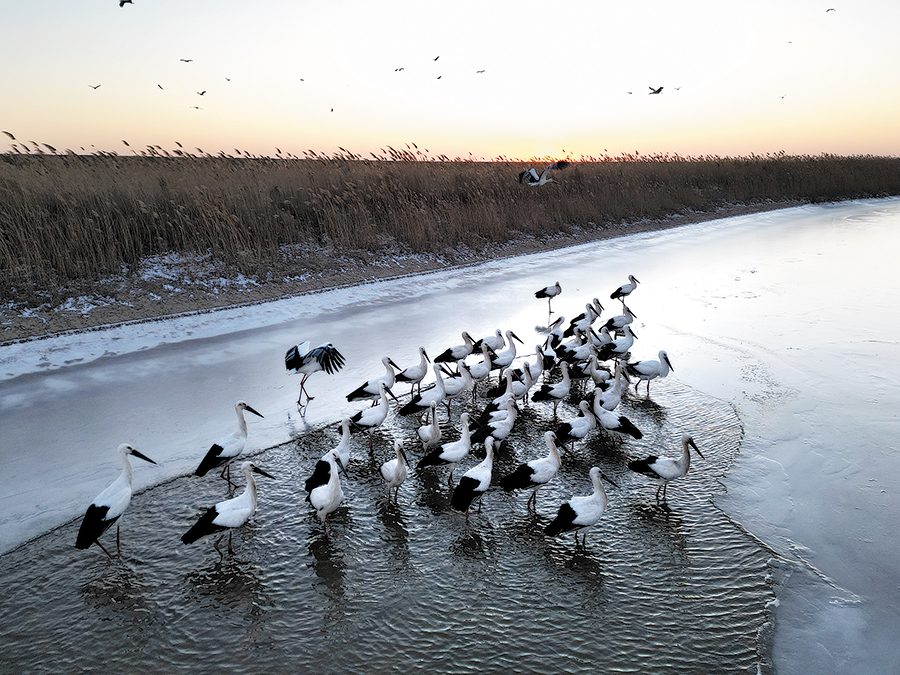 Migratory birds fly over the reserve. XU SUHUI/XINHUA
Migratory birds fly over the reserve. XU SUHUI/XINHUAOn a sweltering late afternoon in June, a tour bus navigated a private road flanked by verdant grass in the Shandong Yellow River Delta National Nature Reserve. Towering reeds stood erect in the wetlands, which reflected the blue sky and its billowing white clouds.
The bus passed a power line pole, on top of which a nest was perched. The nest was sheltering two black and white birds, one standing and the other squatting.
"These two birds are oriental storks that enjoy first-level State protection," said Hu Yuwei, a tour guide in the nature reserve. "You're lucky to be on this bus, because the breeding season for this species will be over shortly. It runs from February to early July, and once the fledglings have learned to fly, they tend to favor wetlands in the central area rather than nest high up on power line poles, making them hard to spot.
"Seen from below, the birds, with their long beaks, necks and legs, seem to be much smaller than they really are," Hu said.
The oriental stork, with red skin encircling its eyes — which some jokingly refer to as eyeliner — stands out from other stork species, she said.
The number of oriental storks is severely depleted, mainly because of habitat loss and overhunting, and they are listed as endangered on the International Union for Conservation of Nature Red List. To address the problem, diligent conservation measures taken by the city of Dongying, Shandong province, have resulted in the species now being frequently seen in an area in which it had once never set foot.
 A wetland area in the Shandong Yellow River Delta National Nature Reserve in Dongying, Shandong province, in October. XU SUHUI/XINHUA
A wetland area in the Shandong Yellow River Delta National Nature Reserve in Dongying, Shandong province, in October. XU SUHUI/XINHUAWetland restoration
The area, in northeastern Dongying at the Yellow River estuary, was once seen as inhospitable for birds and other wildlife because water was scarce during the dry season and overwhelming during the wet season, flooding the land, said Hu, a Dongying native.
Recognizing its ecological, geographical and societal significance, the city established a nature reserve in 1990, which has since grown to 153,000 hectares. The reserve received national-level status and became known as the Shandong Yellow River Delta National Nature Reserve two years later.
Toward the end of the decade, the oriental stork began appearing there.
"The oriental stork is particularly sensitive about its living environment and is considered an indicator of how healthy wetlands are," said Zhao Yajie, deputy director of the ecological monitoring center in the nature reserve. "In fact, it had never been seen in the nature reserve before the late 1990s."
The migratory birds mainly inhabit marshes, wetlands and pond shores. They are found during the summer in the provinces of Heilongjiang and Jilin in Northeast China and the Inner Mongolia autonomous region, and during the winter in Anhui, Hubei, Hunan, Jiangsu and Jiangxi provinces. They are also present in Japan, the Korean Peninsula and Russia.
"In the autumn of 1997, the reserve's first oriental stork was observed pausing here on its journey southward, using the location as a temporary stopover," Zhao said. "In 2003, a group of the storks nested here for the first time, coinciding with the wetland conservation project in the nature reserve that was occurring at the time and underscoring the project's success."
The first successful hatching of the species occurred in 2005, she added.
In 2002, a wetland restoration project was launched in the nature reserve. It involved building dams to prevent seawater from intruding and injecting water from the Yellow River during its peak flow period into the reserve to retain freshwater and reduce salinity. This was an effective way to create a freshwater wetland environment and provide a suitable habitat and food resources for oriental storks, she said.
Rainfall is scarce in the Yellow River Delta in Dongying — only about 590 millimeters a year — and with as much as 1,550 mm of water being evaporated from the wetlands annually, more of it is essential. The reserve has thus adopted replenishment measures, including diverting water from the Yellow River during its peak flow period in June, she said.
Following years of wetland restoration efforts, there are now more than 20,000 hectares of freshwater wetlands in the reserve. The expansion has led to the oriental stork establishing itself as a regular resident of Dongying, where it lives from February to November, she said.
 Oriental storks gather at a wetland area in the Yellow River Delta reserve in Dongying. [Photo provided to CHINA DAILY]
Oriental storks gather at a wetland area in the Yellow River Delta reserve in Dongying. [Photo provided to CHINA DAILY]Habitat creation
As a wading bird species, the oriental stork is between 110 and 120 centimeters tall, weighs 4 to 5 kilograms and has a wingspan of up to 220 cm. However, its timid, vigilant and solitary nature leads it to favor habitats far from human activity and high up in buildings or trees, Zhao said.
"High soil salinity in the Yellow River Delta means the region is unsuitable for tall trees to grow, and oriental storks opt to nest on top of power line poles, which is an electricity hazard," she said. "In addition, the lack of nesting materials makes the nests less secure."
To tackle the problem, the nature reserve has built artificial nests designed especially for the oriental stork since 2007. Positioned on 15-meter-high cement poles, each nest is made of galvanized steel, resembling a bowl with a top diameter of 2.4 meters, a bottom diameter of 1.2 meters and a depth of 35 cm.
Small-scale terrain adjustments have been implemented in the area to cater to the diverse living habits and feeding behaviors of different bird species, enabling waterfowl to frolic in deep waters and wading birds to stand and feed in shallow waters.
Fish fry are released into wetlands every spring to meet the oriental storks' elevated demand for food reserves during the breeding season, Zhao said.
Advanced technology such as artificial intelligence recognition systems and 5G internet have been employed to automatically monitor bird populations and capture real-time data on environmental factors including hydrology, meteorology and air quality. In addition, some key birds have been banded to keep track of their migration patterns.
"Empowered by technology, we can reduce human disruption in wildlife habitats, enhance our understanding of these animals and take prompt action when they are in danger," Zhao said, adding that the rescue principle in the nature reserve is to preserve their wild nature and release them back into the wild once it is possible to do so.
 The Yellow River empties into the Bohai Sea in Dongying. XING GUANGLI/XINHUA
The Yellow River empties into the Bohai Sea in Dongying. XING GUANGLI/XINHUALegal support
Under the guidance of the nation's nature reserve regulation, the Shandong reserve is divided into three zones — core, buffer and experimental — each of which has its own permitted activities and restrictions.
"The area functions primarily as a nature reserve and then as a scenic site," said Hu, the tour guide, adding that the area has adhered to national regulations and confined tourist activities to the experimental zone with stringent controls on the number of visitors.
Last year, the area welcomed 800,000 visitors, a relatively low figure compared with other sites of similar size.
"The city of Dongying obtained the right to establish its own legislature in 2015, and the second substantive local regulation it rolled out was the Regulation on the Shandong Yellow River Delta National Nature Reserve, considering its geographic importance and the significance of its ecological diversity," said Hou Lingxiao, a member of the Dongying People's Congress.
The regulation sets out specific requirements for the management and protection of the nature reserve and its resources, such as the rescue of wild animals, the implementation of a wetland water replenishment mechanism and the prevention of invasive species. In addition, it details the penalties for illegal activities, which according to Hou provides solid legal support for the conservation of the nature reserve.
Following the implementation of the national Yellow River Protection Law last year, Shandong adopted its own protection regulation this year.
The nature reserve, now dubbed "the international airport for birds", has seen the population of oriental storks grow from two nests of seven fledglings in 2005 to 202 nests of 526 fledglings this year, with the number of bird species nearly doubling from 187 in the early 1990s to 373 today, Zhao said.
Zhao attributed these positive outcomes to years of extensive conservation endeavors, which have effectively stabilized the numbers of rare animal species and improved the local environment.
"We hope that the practice in the nature reserve provides insights on biodiversity conservation and environmental restoration, and the area will continue to thrive as the bird's shelter," she said.
�limenghan@chinadaily.com.cn�